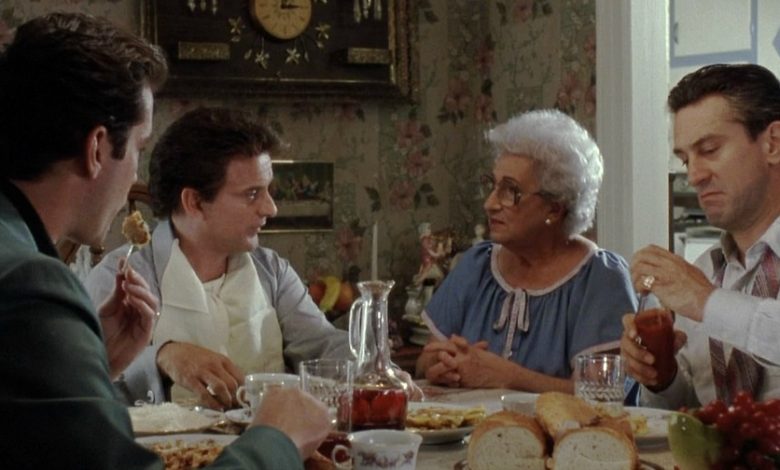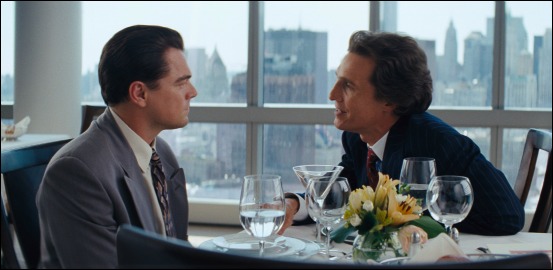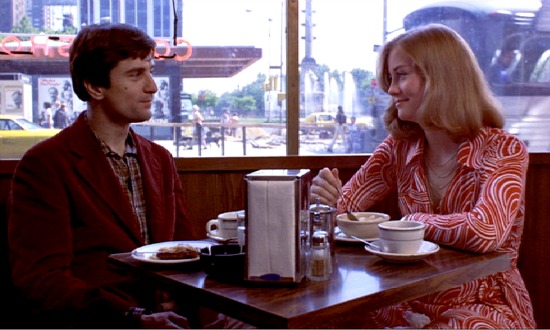Why Scorsese Sets Table for Meaty Dramas

Tommy (Joe Pesci), Jimmy (Robert De Niro) and Henry (Ray Liotta) simply wanted to snag a shovel from Tommy’s mother’s house to help bury the guy.
But when Tommy’s mom (played by Scorsese’s real-life mother, Catherine) wakes up and greets her guests, she insists they stay. “Go inside,” she says. “Make yourselves comfortable. I’ll make you something to eat.”
They have no choice. It’d be rude to turn down a good, home cooked meal—especially in a Scorsese movie.
Setting the Table
In a career spanning six decades, Scorsese has explored the violence of organized crime, the greed of Wall Street and the dizzying complexity of the human soul. While perhaps best known for mafia movies like “Goodfellas,” he’s also directed costume dramas (“The Age of Innocence”) and zany comedies (“After Hours”), psychedelic mysteries (“Shutter Island”) and children’s stories (“Hugo”). He’s as creative and as versatile as any director in Hollywood.
But one consistency seems to run through almost all his work: The significance of food.
Take that scene in “Goodfellas”—where Tommy’s mother welcomes Tommy, Jimmy and Henry in for a bite to eat.
On the surface it’s a picture of twisted normalcy: Tommy’s mom shows off a new painting she’s been given and asks Tommy when he’s going to find a “nice girl.” (“I get a nice one almost every night, Ma,” Tommy says.). Jimmy raves about the food while Henry picks at it, silently sitting to the side. Maybe it’s not so different from the way many American family dinners look and feel.
FAST FACT: Catherine Scorsese appeared in eight of her son’s films.
But the normalcy of the meal hides the brutality of the evening. A huge napkin is draped over the front of Tommy’s shirt—hiding the blood spattered across it. A body lies in the trunk, waiting (not-so-patiently, as it turns out) to be buried. Ma’s table looks like a picture from a Renaissance-era depiction of the Last Supper—the bread, the wine, the grapes. The audience is subconsciously jarred when Jimmy empties what seems like half a bottle of bright, red ketchup on his plate.
Comfort Food
Barry Wurst, former film instructor at the University of Colorado-Colorado Springs and founder of the Hawaii Film Critics Society, says that Scorsese’s attention to food is linked to common themes found in much of Scorsese’s work: His Italian-American heritage, his deep Catholicism and his sense of family.
“Every single movie Scorsese has ever made is about family,” Wurst says. “The need to keep it or maintain it or to start a family.” The scene from “Goodfellas” is a prime example of that sense of family. “That scene is one of the last few moments before things get really, really bad,” he says. “One of the last few moments for them to have a good family.”
Food is also deeply associated with Scorsese’s sense of Catholicism, according to Wurst and others. In her book “The Scorsese Psyche on Screen,” Maria T. Miliora notes that “food is depicted as symbolic communion” in such films as “Who’s That Knocking at My Door?” And “Gangs of New York,” wherein Priest Vallon (Liam Neeson) is given a piece of bread before battle—a stand-in for a communion wafer—which he shares with his son.
Scorsese depicts the literal Last Supper in his controversial movie, “The Last Temptation of Christ.” And in many other movies, Wurst notes, the preparation of a meal takes on the flavor of ceremony. In 1993’s “The Age of Innocence,” food is treated with somber ritual, almost as if every meal was a Eucharistic rite.

It’s interesting to note that, in 2014’s “The Wolf of Wall Street,” food rarely makes an appearance at all. When Jordan Belfort (Leonardo DiCaprio) sits down for lunch with mentor Mark Hannah (Matthew McConaughey), there’s no mention of food: Only martinis to be brought in five-minute intervals until someone collapses.
Our movie’s protagonists ingest liquor and drugs aplenty, but rarely do they actually eat anything of substance. If food is all about family and connection in Scorsese’s work, these characters have neither.
Upset Stomach
But just as Scorsese uses food as a symbolic anchor that connects characters with family and faith, these scenes can cut both ways. Mealtimes are just as effective in locking people out as they are bringing people in.
In Scorsese’s 2004 movie “The Aviator,” troubled inventor Howard Hughes (DiCaprio) sits down for a meal with his then-girlfriend Katharine Hepburn (Cate Blanchett) and her upper-crust family.
Everything about the dinner sets Hughes on edge, from the aggressive conversation to the bloody beef. This is a closed world, he realizes during dinner, that he’ll never have access to.
“We don’t care about money here, Mr. Hughes,” Katharine’s mother tells him.
“Well, that’s because you have it,” Hughes says. He pushes away from the dinner table and stalks off.
RELATED: HiT Rewind: ‘Cape Fear’ (1991)
Wurst notes that, as the movie progresses and Hughes grows ever more isolated, we see that isolation in his rejection of food. “Everything is poisonous,” Wurst says, as Hugh’s surroundings grow ever more fetid and the food spoils around him. “He can’t have a normal relationship with food, let alone people.”
Elijah Davidson of Fuller Theological Seminary’s Reel Spirituality says that Scorsese often uses food ironically: Meals are supposed to be a place of comfort and connection, yes, but often times the characters themselves sabotage this safe haven.

“In Who’s That Knocking At My Door and in “Mean Streets,” the kitchen table is the place where the protagonists feel the most guilt.” Davidson says. “In ‘Taxi Driver,’ the cabbies meet at Hector’s Diner (their kitchen), and this is the place where [Travis] Bickle [De Niro’s unhinged driver] is offered community, though he allows his racism and paranoia to get the best of him.” He notes that in “Gangs of New York,” Daniel Day-Lewis’ unforgettable villain “Bill The Butcher” is, indeed, a butcher—and his bloody lair reflects it.
“There’s an awareness that the kitchen is supposed to be the place where community—such a huge value in Scorsese’s films—is reinforced and things are as they should be,” Davidson says. “However, things rarely are as they should be in Scorsese’s films, and the community is always in peril.”
In short, food in Scorsese’s work—a conduit to relationship—can be as complex as the relationships themselves, fraught with both comfort and anxiety. Dinner can be a place of safety or a conduit to disaster, and sometimes both in the very same meal.
But you can be sure of one thing: Scorsese’s meals are never empty calories.
***
Paul Asay is a movie critic for Plugged In and has written for a variety of websites and publications, including Time, The Washington Post and Beliefnet.com. He’s authored or co-authored several books, including most recently Burning Bush 2.0: How Pop Culture Replaced the Prophet. You can follow Paul on Twitter @AsayPaul, read his blog or visit his website.
